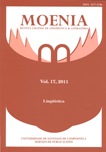El trasvase del feminismo en la literatura juvenil. Estudio de caso en The Once and Future Witches / Las brujas del ayer y del mañana (Harrow, 2020 / Tejera Expósito, 2022)
Contenido principal del artículo
Resumen
Palabras clave:
Detalles del artículo
Referencias
Harrow, Alix E. (2020): The Once and Future Witches. London: Orbit.
Harrow, Alix E. (2022): Las brujas del ayer
y del mañana. Tr. Esp. de David Tejera Expósito. Barcelona:
Roca editorial.
Ajuntament de Barcelona. Género y LGTBI. Guía de comunicación inclusiva para construir un mundo más igualitario. En línea https://ajuntament.barcelona.cat/guia-comunicacio-inclusiva/pdf/guiaInclusiva-es.pdf.
Bacchilega, C. (1997): Postmodern Fairy Tales: Gender and Narrative Strategies. Philadelphia: University of Pennsylvania Press.
Baer, B. J. & Kaindl, K. (2018): Queering Translation, Translating the Queer: Theory, Practice, Activism. New York: Routledge.
Castro Vázquez, O. (2008): “Género y traducción: elementos discursivos para una reescritura feminista”. Lectora 14, 285-301.
Castro Vázquez, O. & Ergun, E. (eds.) (2017): Feminist Translation Studies: Local and Transnational Perspectives. New York: Routledge.
Chollet, M. (2022): In defense of witches. Why are women still on trial? Hampshire: Pan Macmillan.
Colomer Martínez, T. & I. Olid Báez (2009): “Princesitas con tatuaje: las nuevas caras del sexismo en la ficción juvenil”. Textos de didáctica de la lengua y la literatura 51, 55‑67.
D’Arcangelo, A., C. Elefante & V. Illuminati (2019): “Translating children’s Literature: Bridging Identities and Overcoming Stereotypes”. En A. D’Arcangelo, C. Elefante & V. Illuminati (eds.): Translating for Children Beyond Stereotypes / Tradurre pour la jeunesse au-delà des stéréotypes. Bologna: BUP, 5‑24.
Demirhan, H. (2020): “Children’s literature, feminism, adaptation and translation”. En L. Von Flow & H. Kamal (eds.): The Routledge Handbook of Translation, Feminism, and Gender. London: Routledge, 528‑40.
Dépêche, M. F. (2002): “As traduções subversivas feministas ontem e hoje”. Labrys. Estudos Feministas 1‑2. https://www.labrys.net.br/labrys1_2/mfd1.html.
Durrant, J. & M. D. Bailey (2012): Historical Dictionary of Witchcraft. New York: Scarecrow Press.
Engueix Tercero, M. (2019): “Feminismo y traducción: más allá del lenguaje inclusivo”. Vasos Comunicantes (Revista de ACE Traductores) 50. https://vasoscomunicantes.ace-traductores.org/2019/09/30/feminismo-y-traduccion-mas-alla-del-lenguaje-inclusivo.
Federici, S. (2010): Calibán y la bruja. Mujeres, cuerpo y acumulación primiti. Madrid: Traficantes de sueños.
Von Flotow, L. (1991): “Feminist Translation: Contexts, Practices and Theories”. TTR: Traduction, Terminologie et Redaction 4/2, 69‑84.
García de Toro, C. (2020): “La traducción de literatura infantil: temas centrales y nuevas vías de investigación”. Sendebar 31, 461‑72.
Gibbon, M. (1999): Feminist Perspectives on Language. Harlow: Pearson / Prentice Hall.
Godayol, P. (2013): “Gender and Translation”. En C. Millán & F. Bartrina (eds.): The Routledge Handbook of Translation Studies. Abingdon: Routledge, 173‑85.
Hanisch, C. (1970): “The Personal is Political”. En S. Firestone & A. Koedt (eds.): Notes from the Second Year: Women´s Liberation. New York: Radical Feminism, 1‑5.
Hurtado Albir, A. (2013): Traducción y Traductología, Madrid: Cátedra.
Instituto Asturiano de la Mujer (2008): Cuida tu lenguaje, lo dice todo. http://www.mujeresenred.net/IMG/pdf/cuidatulenguaje.pdf.
Irshad, I. & Y. Musarat. (2022): “Feminism and Literary Translation: A Systematic Review”. Heliyon 8/3, https://doi.org/10.1016/j.heliyon.2022.e09082.
Lazar, M. M. (2002): “Consuming personal relationships: The Achievement of feminine self-identity through other-centredness”. En L. Litosseliti & J. Sunderland (eds.): Gender Identity and Discourse Analysis. Amsterdam: John Benjamins, 111‑28.
Lazar, M. M. (ed.) (2007): Feminist Critical Discourse Analysis. Gender, Power and Ideology in Discourse. New York: Palgrave Macmillan.
Ludbrook, G. (2022): “From Gender-Neutral to Gender-Inclusive English. The Search for Gender-Fair Language”. DEP. Deportate, Esuli, Profughe 48, 1‑20.
Meneses, A. (2020): “¿Lenguaje para todes?”. En Academia Chilena de la Lengua (ed.): Sexo, género y gramática. Ideas sobre el lenguaje inclusivo. Santiago de Chile: Catalonia.
Ortega Sánchez, D. & V. Juez Fuentespina (2021): “Deconstruyendo identidades de género: análisis de los roles narrativos de las brujas en la literatura infantil”. Anuario de Investigación en Literatura Infantil y Juvenil 19, 93‑114.
Pereira Rodríguez, A. & L. Lorenzo García (2020): “Cinderboy and Snow White and the Seven Aliens: Analysis of the Rewriting of Two Classic Tales and Their Translations to Spanish”. En L. Brugué & A. Llompart (eds.): Contemporary Fairy Tale Magic. Subverting Gender and Genre. Leiden: Brill / Rodopi, 77‑88.
Quintano Martínez, P. (2021): “«Las brujas que no pudiste quemar». Reconstrucción y resignificación de la bruja como figura femenina monstruosa dentro del movimiento feminista”. En E. Gómez Nicolau, M. Medina Vicent & M. J. Gámez Fuentes (eds.): Mujeres y resistencias en tiempos de manadas. Alicante: Servicio de Publicaciones de la Universitat Jaume I, 101‑21.
Robinson, D. (2019): Transgender, Translation, Translingual Address. London: Bloomsbury Academic.
Shavit, Z. (2006): “Translation of Children’s Literature”. En G. Lathey (ed.): The Translation of Children’s Literature: A Reader. Clevedon & Tonawanda: Multilingual Matters, 25‑41.
Simon, S. (1996): Gender in Translation: Cultural Identity and the Politics of Transmission. London: Routledge.
Sollée, K. J. (2017): Witches, Sluts, Feminists. Conjuring the Sex Positive. Berkeley: ThreeL Media, Stone Bridge Press.
Tang, J. (2022): “Evaluative language and gender stereotyping: a case study of the perpetuation of sexism in literary translation”. Perspectives 30/6, 1027‑42. https://doi.org/10.1080/0907676X.2022.2050930
Universidad de Valencia. (2012): Guía de uso para un lenguaje igualitario (castellano). Valencia: Tecnolingüística.
Valero Cuadra, P., G. Marcelo Wirnitzer & N. Pérez Vicente (2022): “Pasado, presente y futuro de la traducción de literatura infantil y juvenil”. En P. Valero Cuadra, G. Marcelo Wirnitzer & N. Pérez Vicente: Traducción e intermedialidad en literatura infantil y juvenil (LIJ): orígenes, evolución y nuevas tendencias . Translation and intermediality in children’s and young adults’ literature: origins, development and new trends. MonTI 14, 8‑29. http://dx.doi.org/10.6035/MonTI.2022.14.01
Zwissler, L. (2018): “'I am That Very Witch': On The Witch, Feminism, and Not Surviving Patriarchy”. Journal of Religion and Film 22/3, 1‑33.







